A Modest Menagerie of Motmots
Are there nine, twelve, thirteen – or maybe even fourteen species of this Neotropical family?
Motmots are loved by everyone. But what makes them so appealing? There’s certainly something attractively tropical about them – perhaps it’s their large size and stolid way of just sitting there, observing the world around them. But our raptors and pigeons share those qualities, so it’s not just that. This Amazonian Motmot in Apolo, Bolivia sat still for quite some time.
Could it be their tropical colors? But most are rather subdued combinations of mossy green, brown, olives. Even with some subtle highlights of iridescent blue, violet, or turquoise around a black mask they can’t really compare with reds, purples, and rainbows of trogons or bee-eaters. But there sure is something irresistible about the violet-framed mask of the Russet-crowned Motmot, this one in Tuxtla Gutierrez, Chiapas, Mexico.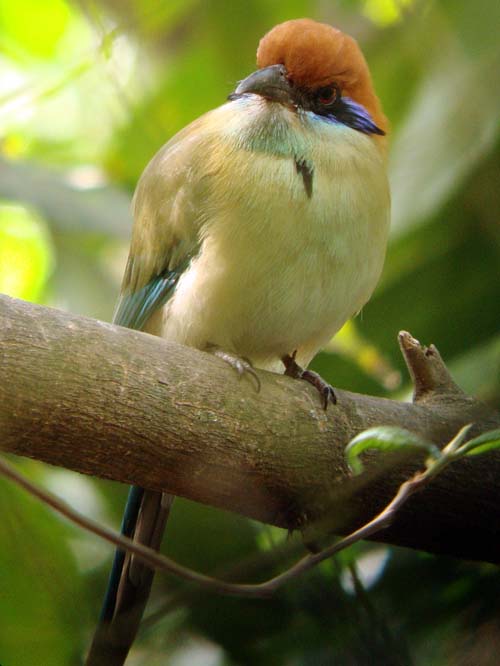
Perhaps it’s the long tail, so curiously tipped in these amazing racquets. Several birds in very disparate families have tail feathers like these, such as hummingbirds and drongos, but the motmots take it to an extreme, such as the Turquoise-browed Motmot at top, which is common on the Yucatan Peninsula, Mexico. While most motmots are forest understory species, this species actually does quite well in open country, such as this one outside our bus in a Costa Rican pastureland.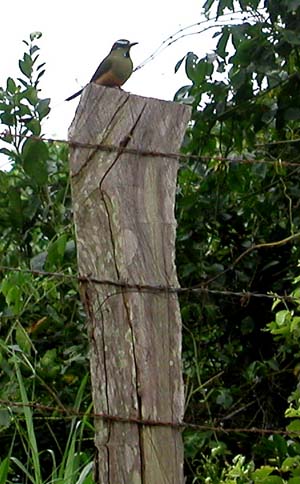
But not all have the racquets, such as this Broad-billed Motmot from Madidi National Park in Bolivia. Though this species and Rufous Motmot do have racquets in Central America, they don’t in South America.
Why is it called Broad-billed Motmot? How about this close-up from one amazingly unwary one I had while leading at tour at La Selva Biological Station in Costa Rica.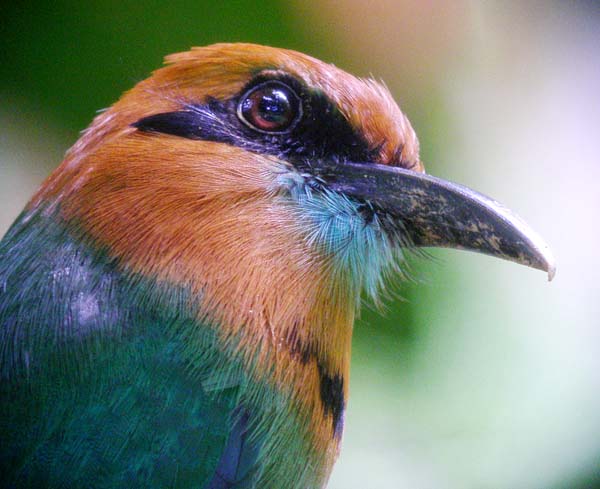
The small Tody Momot of Central America is the cutest of all – and they don’t even have a long tail. This one was amongst the ruins at Chan Chich Lodge, Belize.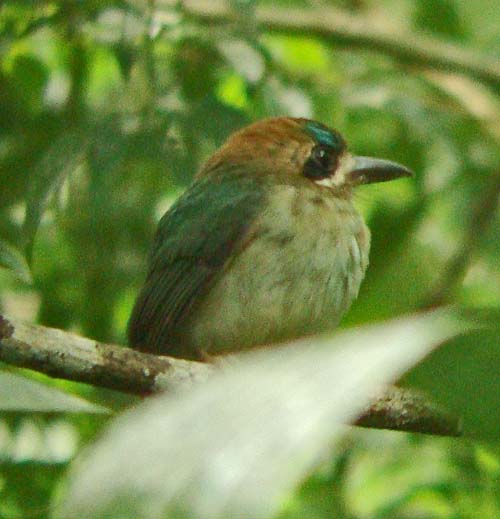
Some are prized for their rarity, such as this Keel-billed Motmot at Arenal, Costa Rica, one that many birders have seen here over the years. It seems to be paired with a Broad-billed Motmot.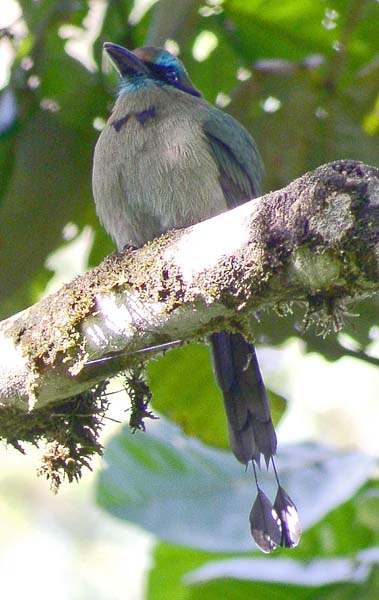
I saw my ninth – and final – species of motmot this past March in the form of the elusive Blue-throated Motmot while co-leading with Steve Howell in the highlands of Chiapas. But then…ooops…Gary Stiles published a paper in Ornitología Colombiana that resulted in the splitting of the Blue-crowned Motmot into four species in South America. Though he didn’t deal with the taxa to the north, the implication is that the one from western Panama north is yet at least one more species. This one here feeding on bananas at the Las Cruces Biological Station in southern Costa Rica is the subspecies Momotus momota lessonii, which people are now calling the Blue-diademed Motmot, though the AOU hasn’t made that name change official.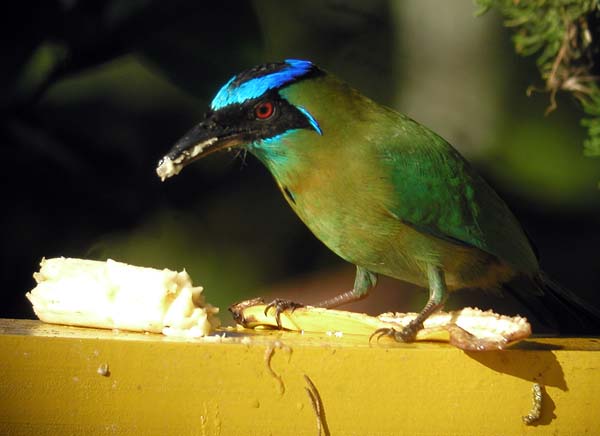
Let’s not forget the only Blue-crowned Motmot that actually has a blue crown (all the others have a black central crown) – Momotus momota coeruliceps from NE Mexico, which we see at the lovely Rancho del Cielo on my tours there. Crown color is one of the features that Stiles pointed out as being important in separating the southern species, yet none of them have a crown as distinct as this one. I guess we’ll have to wait for a study that incorporates DNA before the AOU will act on this one.
In the meantime, I have to figure out some way to get to Trinidad – with the new split, I’m now missing Trinidad Motmot!
—
Addendum: Here is a complete list of the motmots and their distributions.
Tody Motmot, Hylomanes momotula (S Mexico to NW Colombia)
Blue-throated Motmot, Aspatha gularis (S Mexico Mexico to Honduras)
Russet-crowned Motmot, Momotus mexicanus (NW Mexico to Guatemala)
Blue-diademed Motmot, Momotus lessonii (NE Mexico to W Panama)*
Whooping Motmot, Momotus subrufescens (C Panama to NW Peru)
Trinidad Motmot, Momotus bahamensis (Trinidad and Tobago)
Amazonian Motmot, Momotus momota (Amazonian South America)
Andean Motmot, Momotus aequatorialis (Andes from Colomibia to Bolivia)
Rufous Motmot, Baryphthengus martii (Honduras to Bolivia)
Rufous-capped Motmot, Baryphthengus ruficapillus (S Brazil to NE Argentina)
Keel-billed Motmot, Electron carinatum (SE Mexico to NE Costa Rica)
Broad-billed Motmot, Electron platyrhynchum (Honduras to Bolivia)**
Turquoise-browed Motmot, Eumomota superciliosa (S Mexico to NW Costa Rica)
*This name change has not been accepted by the North American Classification Committee and is implied by the four-way split of four other Blue-crowned Motmot taxa in South America by the South American Classification Committee – which is always a few steps ahead of the NACC.
**The Central American and South American forms may be separate species. The northern one is the nominate, and if split the Amazonian form would be called Plain-tailed Motmot, Electron pyrrholaemum.

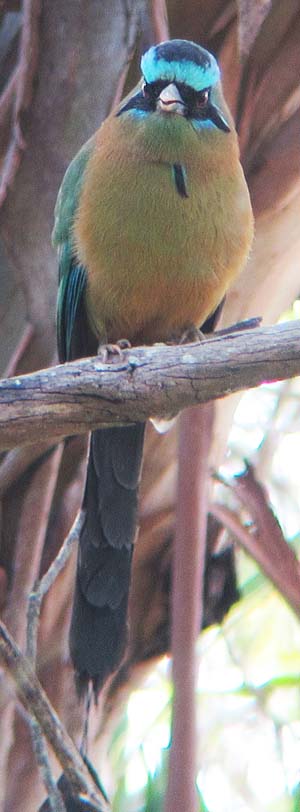
Beautiful Birds!
Great article!
I like motmots because of the way they rock their tails back and forth like the pendulum on a grandfather clock. I saw a Rufous Motmot doing this near Puerto Maldonado, Peru even though 90% of its tail was missing!
I would like to make one minor correction. Broad-billed and Rufous Motmots do have racquets in northwestern South America.
Ah, yes, Thanks Scott. I should have said “Amazonian South America.” Almost all the birds from the NW have affinities with Central America. I might have added that I’ve only “heard” the newly Whooping Motmot from SW Ecuador, but it’s the voice that makes that one really stand out.
I am awed by these fantastic creatures! The tails are amazing. Bravo on the photography.